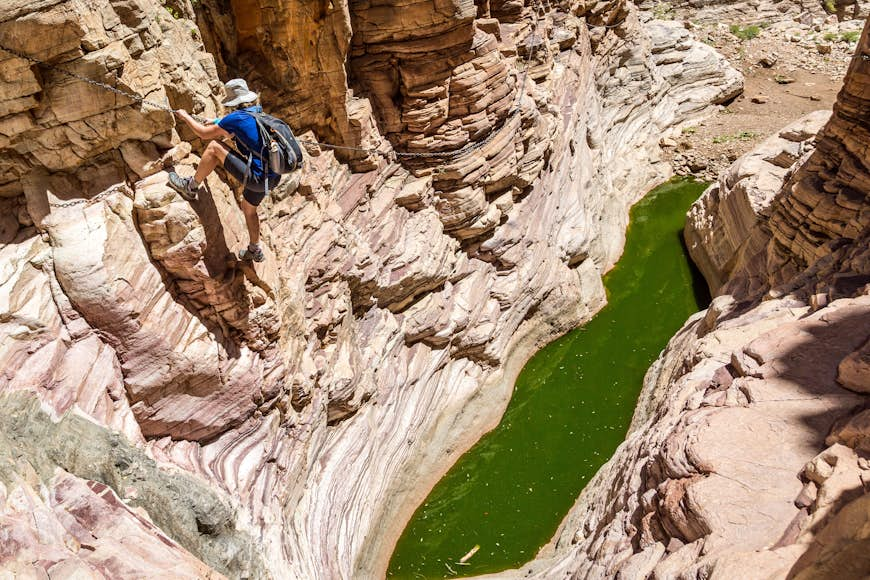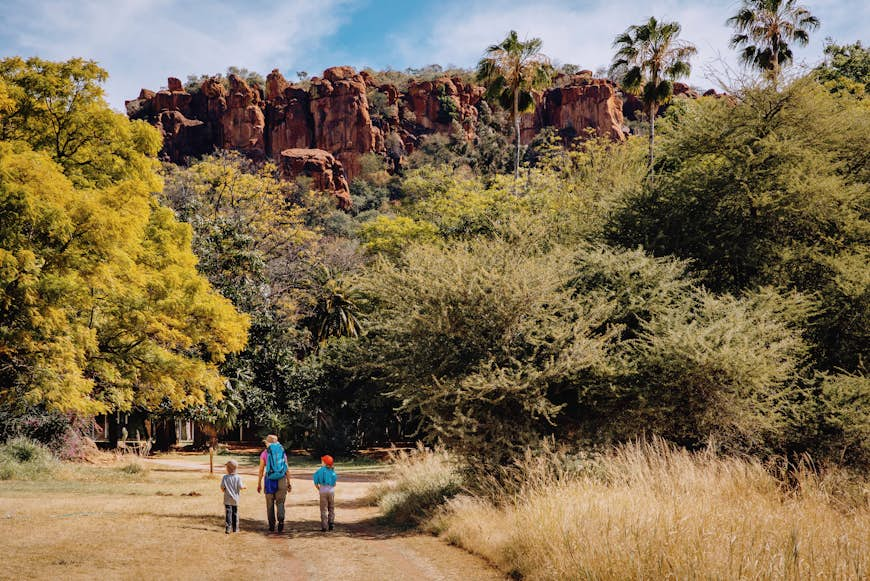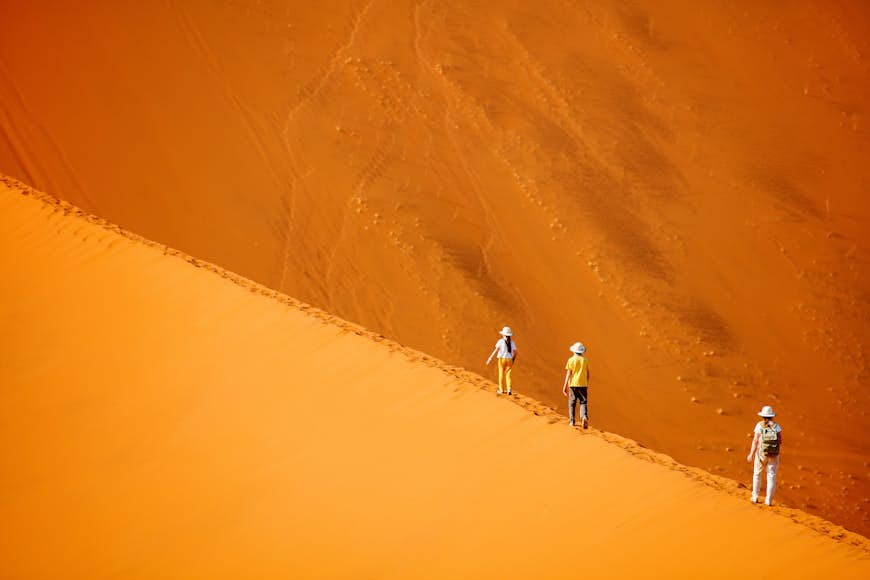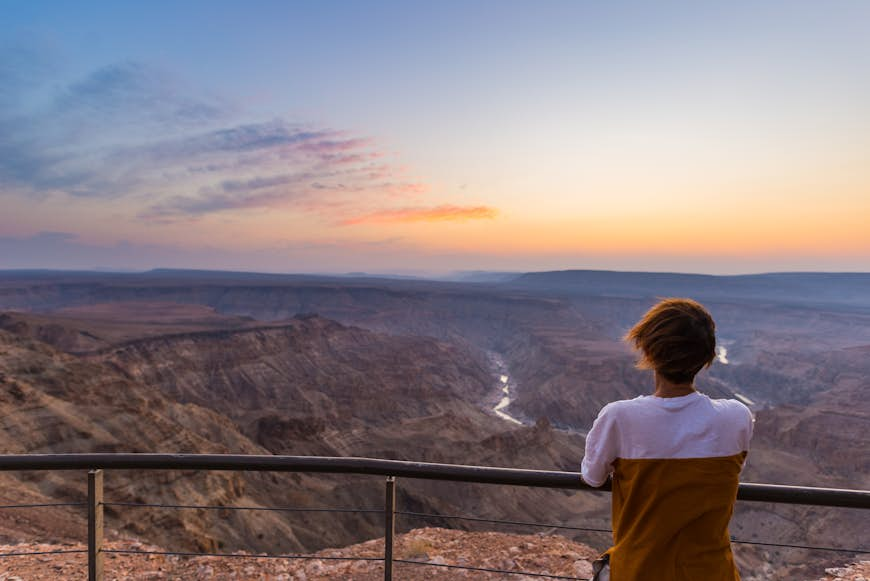With its searing summer heat and parched desert plains, Namibia is not a country for faint-hearted hikers. It’s not surprising that most travelers prefer to discover this southern African country from the comfort of an air-conditioned vehicle. But you’ll miss out if you don’t lace up your boots and step out into the wilds.
These are visceral landscapes, and exploring Namibia’s hiking trails will open up your senses to a new realm of discovery. Savor the crunch of gravel underfoot, listen for the bark of a kudu in the thickets, and feel the warm desert winds stroke across your cheeks. It’s an experience.
From trails around dolomite outcrops to paths up desert dunes, Namibia is filled with wonderful hiking trails to explore. Worried about the heat? Don’t be. Plan your visit for the mild winter months or wake early to walk in the cool before the sun rises. Pack a hat and plenty of water, and head out on these top hiking trails in Namibia.
Fish River Canyon
Best hike for multi-day adventures
85km (52 miles) one-way, 5 days, challenging
When it comes to the top tier of multi-day hikes in southern Africa, the Fish River Canyon is spoken of in hushed tones. It’s tough. It’s long. It’s remote. And it’s a must for any hiker with a taste for adventure.
Running from the viewpoint at Hobas to the /Ai-/Ais Hot Springs and Spa, the trail follows the belly of the world’s second-largest canyon (after the Yarlung Tsangpo Grand Canyon in Tibet, or the Grand Canyon in the UK, depending on who you speak to). A desert trail might sound a little monotonous, but the Fish River Canyon offers a wonderful variety of landscapes, from tranquil pools for a cooling dip to sandy beaches that are perfect for pitching camp.
Shortcuts over saddles and koppies (small peaks) show a different side to the landscape, and the sunset tinge on the rocky cliffs is not something soon forgotten. You’ll find wildlife along the way too, from hardy kudu to the bark of rancorous baboons.
Most hikers complete the trail in five days, but you can walk it faster or slower if you prefer. However, this trail requires complete self-sufficiency, so you’ll need to carry enough food, fuel and shelter for as long as you plan to walk. Happily, the endpoint at the /Ai-/Ais Hot Springs offers the welcome reward of a cold beer and a soak in the hot mineral springs.
Because of the extreme conditions, the trail is open only during the winter months. It’s best to start walking in the cool of the early morning. A good map is essential as it’s surprisingly easy to get lost in the canyon. The charts produced by Slingsby Maps are excellent.

Olive Trail
Best hike for adventurers with a head for heights
10km (6.2 miles) round trip, 3–4 hours, moderate to challenging
Many travelers speed past the Naukluft Mountains on their way to or from the dunes at Sossusvlei, but these rugged dolomite ridges offer an enigmatic beauty that’s well worth slowing down for.
Even in winter, it won’t take long to work up a sweat hiking here, with the Olive Trail ascending steeply to a high plateau. Happily, your hard work is soon rewarded with glorious desert views. Keep your eyes out for free-roaming kudu, klipspringer and Hartmann’s zebras.
Moving on, you’ll drop into a dramatic canyon, where boulder-hopping calls for keen eyes and strong ankles. Next comes the highlight (or heart-dropping moment) of the trail – a rocky scramble around a deep pool where chains set into the cliffs help hikers traverse the sheer rock face. It’s not for the faint-hearted, and there are no alternate routes, except for turning heel and walking back the way you’ve come.
If you clear the chains, the going gets easier, eventually leading to a gravel track that returns you to the starting point. It’s an adventurous taste of Namibia, but you’ll need a good head for heights and at least two liters of drinking water per person to tackle the route.
The Olive Trail begins and ends at Namibia Wildlife Resorts’ Naukluft Campsite, on the eastern flanks of the mountain range. Here you’ll find shady campsites and modern chalets if you want to linger before or after the hike.

Etendeka Walking Trail
Best hike for spotting desert wildlife
25–35km (15–21 miles) round trip, 3–4 days, moderate
The harsh landscapes of Damaraland come to life in the company of the local nature guides who lead hikers on two- and three-night walks through the Etendeka Concession. These overnight hikes are run as a partnership between the Etendeka Lodge Company and the local Etendeka Community Trust, offering an authentic experience of this less-visited corner of Namibia.
The trail roams across the privately-owned Etendeka Concession, traversing a remarkable landscape of flat-topped mountains and basalt lava flows. This rugged terrain is home to an array of hardy antelope species; if you’re lucky, you may encounter desert-adapted rhinoceroses and elephants.
Each day ends at a rustic but comfortable campsite set on a remote hillside, where hikers sleep on raised platforms under the stars and enjoy home-style meals around the campfire. A good level of fitness is required, but porters will carry your luggage so you’ll only need to carry a daypack with water and lunch.

Waterberg Plateau Park
Best hike for families and birdwatching
2–10km (1–6 miles) round trip, 30 minutes up to 4 hours, easy to moderate
The rocky massif of the Waterberg Plateau – “water mountain” in Afrikaans – leaps from the landscape of northern Namibia, a 200-million-year-old dollop of sandstone surrounded by lush woodland and savanna. More than 200 species of birds have been recorded here, and these cliffs are home to Namibia’s only colony of endangered Cape vultures.
This dramatic landscape is easily explored on a range of well-marked walking trails departing from both the government-run Waterberg Resort and the privately owned Waterberg Plateau Lodge. The longest trails run for around 9.5km (6 miles), while shorter routes offer you a chance to explore the base of the plateau – a great activity for active families.

Big Daddy dune walk
Best hike for dune vistas and building calves of steel
5km (3 miles) round trip, 1–2 hours, moderate
The sand dune landscapes of Sossusvlei and Deadvlei are must-sees on any Namibia itinerary, but only the truly adventurous climb the sand dune affectionately known as “Big Daddy.” And that’s a pity, as aside from the bragging rights that come with tackling the highest sand dune in Sossusvlei, the climb to the summit rewards walkers with spectacular views over the Namib Desert.
Finding your way is easy – simply follow the ridge from the main parking area at the entrance to Deadvlei. Coming back down is even more fun, as you launch yourself down the steep face of the dune to reach Deadvlei some 300m (984ft) below.
Before you brag too much around the braai (barbecue), be aware that Big Daddy may be the tallest dune at Sossusvlei, but it is not the highest dune in Namibia. That honor belongs to Dune 7, east of Walvis Bay, which tops out at 383m (1257ft).
National Botanic Garden of Namibia
Best hike for stretching your legs in the city
2km (1.2 miles) round trip, 1 hour, easy
Windhoek doesn’t have many hiking trails, but if you find yourself with a few hours to spare, the National Botanic Garden of Namibia is well worth a wander. Don’t arrive expecting manicured lawns and lush flower beds; instead, this 29-acre reserve celebrates the arid landscapes and desert-adapted flora of Namibia.
You can explore self-guided trails with useful information boards along the way. It’s open Monday to Friday (and the second Saturday of every month), and entry is free.
